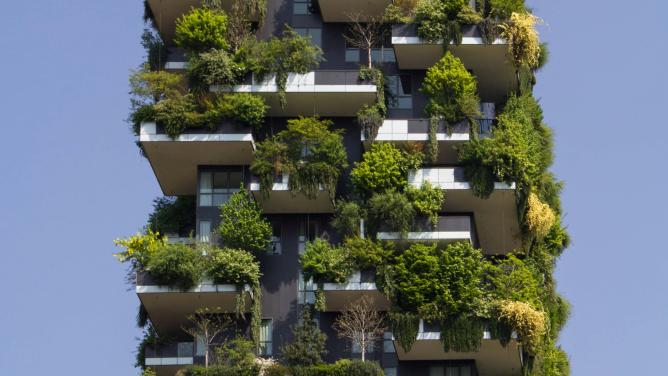Chrono-what?
Architecture and urban planning are often described as disciplines linked to space and how its organised and optimised. The chronotopic approach suggests combining more systematically a temporal dimension. It is the heir to the concept of “temporal geography,” developed in the 1970s at Lund University, or to the idea of “rhythmanalysis,” put forward by sociologist Henri Lefebvre. The concept found its current definition at the end of the 1990s with research from the Politecnico di Milano, which gave prominence to the question of the time-based usage. These days, chronotopic urban planning is emphasised in order to optimise the use of space, but also to foster social cohesion or to protect resources. One of the main positive impacts of chronotopia can be found in its environmental dimension. Space optimisation is already a form of decarbonisation, which also creates land use savings.
“Underuse” a central theme
While urban sprawl and land artificialisation is condemned, and population growth puts cities under pressure (particularly in countries in the Global South), urban spaces remain underused. About 10% of homes remain vacant among OECD countries. As for offices, the average occupancy rate across Europe currently comes in at 55%. Even pre-pandemic figures (70%) reveal a strong potential for optimisation. The same can be said for roads and parking spaces. Car parks often experience a strong variation in occupancy rates. While it is often impossible to find a parking space during peak hours, the average occupancy rate of underground car parks in the city of Paris barely goes above 40%.
Reversibility, pooling, hybridisation
This is the context in which chronotopia comes into play, by proposing to correlate modes of use with temporality. In practice, this translates into a certain number of practices, such as reversible uses, space sharing or hybrid practices.
Reversibility mainly comes into play in the long term, in the sense that buildings can evolve at the same time as needs. While certain examples immediately spring to mind, such as the possibility of transforming office spaces into housing and vice versa, there are other interesting forms of reversibility. In Palaiseau, France, the (sublime) Rosalind Franklin student halls of residence is emblematic. Winner of the 2021 Equerre d’Argent in the housing category, it features two car park levels which can be transformed into housing depending on the future level of car use.
Over a shorter period of time, pooling and hybridisation of uses are undoubtedly the best ways to redouble a building’s use. Basically, monofunctionalily should urgently be considered as a thing of the past, which “like monoculture drains and destroys biodiversity,” to use the words of Sénamé Koffi Agbodjinou, the Togolese architect behind the HubCité project. In fact, this is becoming more frequent as spaces with variable uses are emerging, such as schools which are open to locals on weekends, or initiatives such as Paris Plage, as well as certain third places whose functions are voluntarily left to their users to decide.
When it comes to roads, various experiments have helped bring to life the possibility of a street or road that is more reconfigurable depending on the time of day. For example, in 2018, architect Carlo Ratti proposed Dynamic Street, which featured a system of configurable paving stones used to transform a street from a space for traffic to a space for play. Meanwhile, the Starling Crossing system, which was tested in London in 2017, consisted of an interactive street that responded dynamically in real-time to the actions of its users. Another more concrete example can be found in Paris, where the city council is developing specific lanes dedicated to carpooling at specific times in order to adapt to commuting times.
Event city, ephemeral city
Behind the idea of chronotopia also lies the emergence of a less static city. Luc Gwiazdzinski, geographer and professor at ENSA in Toulouse, talks about a “malleable city” and “the versatility and modularity of space.” This type of city is one which adapts to a world of uncertainties, and to individuals who are both poly-active and poly-topic. In this city, periods of dormancy are taken advantage of, such as with Caracol, which offers temporary shared social accommodation in empty spaces which are awaiting renovation or whose function are in the process of being changed. This type of city is also the city of urban acupuncture or tactical urban planning, which allows residents to reclaim space. Embodied by Parking Days – which is now a worldwide initiative – this trend is paradoxically becoming institutionalized. This is can be seen with the ephemeral terraces (or “parklets”) which have now become a regular feature on the streets of Paris in the summer.
The risk of conflict of use
For urban planner Sylvain Grisot, chronotopia means imagining a “complex city,” which underlies possible conflicts of use which do not exist with a monofunctional city. However, this complex, malleable and shared city requires strong cultural adaptation. According to the Union Sociale pour l’Habitat, it is imperative that shared spaces are slowly introduced into housing (ideally 5% of the living space) in order to “initiate a communal dynamic” without rushing users. The issue of chronotopic governance still largely remains to be invented, but it implies giving a more important place to residents when co-designing a city, while imagining new charters of use for collective space.


